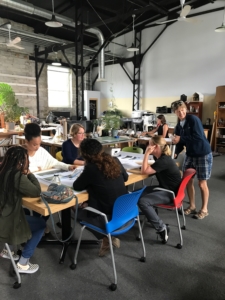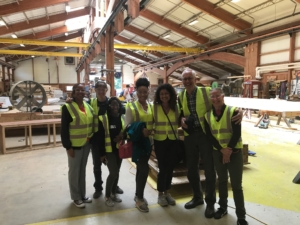This past August members of the School of Architecture’s 2018 Department of Energy Race to Zero Competition team traveled to Vermont to research the cutting edge trends in high performance residential design and modular construction. Three students, Moriah Colbert, Kennia Lopez and Kaylah Wesley, represented the student team members on the trip. Shelly Pottorf, the Faculty Lead for the Race to Zero team, organized the trip and accompanied the team to direct research in preparation for the development of a modular home construction system. Shannon Bryant, Shop Supervisor, also accompanied the team and to help guide in decision making about how the modular home design-build program will be implemented through our new 26,000 square foot Fabrication Laboratory which will be opening Spring 2018. Billie Evans, Customer Service Coordinator, provided administrative assistance for the trip.
 The team spent a busy three days touring Vermont and New Hampshire to see first hand how architects and builders are addressing the challenges of sustainability, energy performance, durability and affordability in the design and construction of single family homes. Upon arrival the team was initiated into the Vermont experience by touring Open View Farm, an organic farm/solar farm where they learned how the solar farm works and how it integrates into the farming operation. Of course they also had their first real taste of farm fresh pizza and maple syrup! The next day was then spent in Middlebury visiting two architecture firms who focus on high performance home design: McLeod Kredell Architects and Vermont Integrated Architecture (VIA). Each architect walked the team through their design process and how they address the issues that they are tackling in home design. The day ended with a tour of two Middlebury College entries into the Department of Energy’s Solar Decathlon.
The team spent a busy three days touring Vermont and New Hampshire to see first hand how architects and builders are addressing the challenges of sustainability, energy performance, durability and affordability in the design and construction of single family homes. Upon arrival the team was initiated into the Vermont experience by touring Open View Farm, an organic farm/solar farm where they learned how the solar farm works and how it integrates into the farming operation. Of course they also had their first real taste of farm fresh pizza and maple syrup! The next day was then spent in Middlebury visiting two architecture firms who focus on high performance home design: McLeod Kredell Architects and Vermont Integrated Architecture (VIA). Each architect walked the team through their design process and how they address the issues that they are tackling in home design. The day ended with a tour of two Middlebury College entries into the Department of Energy’s Solar Decathlon.
On day two the team visited a newly completed small footprint home designed in accordance with Passive House principles. Passive House Builder Kelly Murphey walked the team through the building structure, envelope and systems, enabling them to see first hand how it all comes together to meet the best energy performance possible prior to adding a renewable energy source. The team then toured Yestermorrow Design-Build school to learn more about the design-build process, particularly in regards to sustainable design. The day ended with a tour of Tiny Drop, a tiny home design-build research project by Professor Pottorf and Ms. Bryant. This further demonstrated how issues of structure, envelope and systems are integrated for high performance.
 Day three was dedicated to tours of the factories of two cutting edge modular home builders. First the team headed over to New Hampshire to tour Unity Homes. Owner Ted Benson spent half the day sharing his vision for the company as well as the design and build systems that they have developed to meet their performance and affordability goals. The last stop of the tour was VerMod homes back in Vermont. Ashley Andreas walked the team through the features and associated costs of their designs as well as the possibilities and limitations of modular construction. The team toured a home under construction and then watched as another home was lifted and placed on the truck that will deliver it.
Day three was dedicated to tours of the factories of two cutting edge modular home builders. First the team headed over to New Hampshire to tour Unity Homes. Owner Ted Benson spent half the day sharing his vision for the company as well as the design and build systems that they have developed to meet their performance and affordability goals. The last stop of the tour was VerMod homes back in Vermont. Ashley Andreas walked the team through the features and associated costs of their designs as well as the possibilities and limitations of modular construction. The team toured a home under construction and then watched as another home was lifted and placed on the truck that will deliver it.
The trip was an extraordinary, behind the scenes learning experience for the entire team. It helped to open up the world of possibilities that can be achieved through the PVAMU School of Architecture design-build program. Here is what the students and faculty have to say:
“It is so incredibly important for our students to be exposed to first-hand experiences of how the architecture and construction industries are responding to the pressing challenges of our time: social and environmental justice issues. These are the issues that we have been tackling through the Race to Zero Competition. Ultimately, these efforts will enable us to launch a design-build program that truly addresses these challenges and fulfills the University’s focus on serving our community.” – Shelly Pottorf, AIA, Adjunct Assistant Professor
“It was profoundly rewarding to see the students engage with small firm architects, modular home builders, constructors of energy efficient homes, and organic farmers in the actual living environment in which these professions and livelihoods exist. The students interacted with a natural ecology and social fabric different from what they know. It is this part of their education that will have a lasting effect on their evolving perspectives, decisions, and designs.” – Shannon Bryant, Shop Supervisor
“Vermont is a small state doing BIG things. I was impressed because the environment is a consideration and the residents are doing their part to create a more livable society for today and the future. Vermont is a great example of how a state, and communities throughout, that is involved and caring, can come together to keep the balance between the environment and the Earthlings within.” – Kennia Lopez, Student: Bachelor of Science in Architecture w/ Minor In Construction Science
“The trip to Vermont was very eventful and a great learning experience. To see four different ecological types of sustainability (farmland, city, country and lakeside) really opened my eyes to the possibilities and wide range of design opportunities you can encounter. I appreciate this trip and it will be one of my favorite trips within the school of Architecture.” – Kaylah Wesley, Student: Bachelor of Science in Architecture w/ Minors in Art and Construction Science
